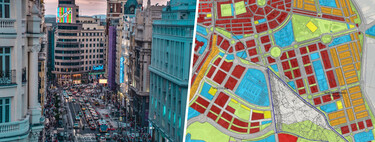Madrid begins the countdown to have a new and large pool of apartments in the north, relevant news if you take into account how tense its market is and the serious housing deficit that it has. The Alcobendas City Council has just given the green light to the partial plan for the new neighborhood of Los Carriles-Valgrande, a new (and enormous) area of the town that will have around 8,600 homes, a good part of them (more than 4,600) protected.
We will still have to wait before seeing the new blocks built, but its promoters are already anticipating that it will be “the largest urban development project in the north of Madrid”, with a wide range of residential, services and parks.
What has happened? That Madrid is a little closer to strengthening its residential offer with an injection of 8,600 homes, a good part of them under protected regime. And that is always news in a market like the capital, marked by the escalation of prices (both in sales and rentals), increasingly draconian access conditions and the imbalance between supply and demand.
In fact, in one of its latest reports, the Association of Real Estate Developers of Madrid (Asprima) states that to meet the community’s demand it is necessary to create 40,000 homes per year, well above the volume of new construction that is being generated right now. As a reference, remember that last year “a maximum peak” of 23,500 homes was delivered and everything indicates that the pace of completions will not reach that mark in the coming years either.

Where will they be built? These 8,600 new homes will be built in Los Carriles-Valgrande, a new (and ambitious) neighborhood planned in the municipality of Alcobendas. The initiative is interesting for several reasons. In addition to strengthening the offer, its promoters boast that it will be “the largest urban project” in the north of the community and one of the developments “with the highest proportion of affordable housing.” In addition, it will “complete” Alcobendas up to its limit with the capital.
The new buildings will arrive accompanied by hectares of green areas, two new parks and more than 55,000 m2 dedicated to the tertiary and commercial sector. Its implementation will also generate employment: the Alcobendas City Council speaks of 4,000 jobs during construction and more than a thousand once the neighborhood is completed. In terms of mobilized capital, it is estimated that the investment will be around 2,300 million euros and the return for the municipality will be around 511 million.
Do you know anything else? Yes. Of the 8,600 homes that will be built, around 4,600 (54%) will be protected and 40% will be built on municipal plots. The project also includes the creation of 570,000 square meters of green areas and open spaces, which will include two new and large parks, one next to Monte de Valdelatas and another near the Valdelacasa stream.
“Each one will have dimensions equivalent to six times the size of the Andalusia Park in Alcobendas,” say the project promoters, who recall that all the trees that are affected by the urbanization will be replaced. In fact, they estimate that the area will go from having 2,555 to more than 6,700.
The urban planning dossier specifies that in total it will occupy about 2.17 million square meters, of which about 57% will be public surface. 25% will be dedicated to green areas and almost 20% to equipment and services. Once it goes ahead, its promoters estimate that it will be able to accommodate around 25,800 inhabitants, a considerable population injection for the area if one takes into account that right now Alcobendas has (according to the INE) 121,400 registered residents.

Why is it news? The project is not new. In fact, Leopoldo Arnaiz, manager of the Valgrande compensation board, remembers that there are people who have been working there for more than 20 years. If it is news now it is because it has just overcome a key obstacle at a bureaucratic level: on Tuesday the local plenary session of Alcobendas gave the green light to the new partial plan, which will allow further progress in the processing of the urbanization. The approval has also been majority: the plan went ahead with the favorable photo of 26 of the 27 councilors of the corporation.
“With the approval of the new partial plan we offer legal security for buyers, investors and to continue with the urbanization project in the area and maintain the action schedule,” highlights the mayor of the town, Rocío García Alcántara. Among other issues, the document details the distribution of homes, public spaces and parks, marks the location and layout of roads and what land will be reserved, for example, for green areas.
And from now on? The step is also important because it helps the development overcome the legal obstacles it had encountered. At the time, the Supreme Court delayed it due to a technical defect after noticing a failure in the strategic environmental evaluation of an artificial mountain. Once the urbanization works allow it, the idea is to start the work to build blocks and have the first homes “as soon as possible”, although the City Council does not specify dates.
“The final approval of the partial plan is great news,” claims Arnaiz. “Today we take a decisive step. We continue to advance and comply with the roadmap that we announced in June. And we reaffirm our commitment to this development, because it is viable, sustainable and necessary, since it responds to a real demand from the residents of the municipality and the north of Madrid.”
Images | Valgrande and Alcobendas Town Hall
In WorldOfSoftware | Madrid needs to decentralize its tourism if it does not want to suffocate. So he’s betting on a “Chinatown” in Usera












